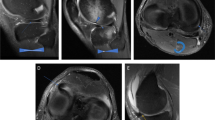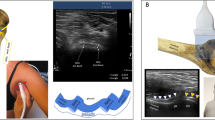Abstract
Purpose
This study was undertaken to assess the reliability of the posterior approach under ultrasonographic guidance (PAUGA), with the arm abducted, before performing direct magnetic resonance (MR) arthrography of the shoulder.
Materials and methods
A total of 111 (82 men, 29 women; mean age, 24 years) underwent direct MR arthrography of the shoulder. Patients were enrolled because of glenohumeral instability (n=71), chronic shoulder pain (n=25), suspicion of rotator cuff tear (n=13) and adhesive capsulitis (n=2). Patients were placed in the lateral position, on the contralateral side to that being examined; the arm of the shoulder undergoing the examination was placed in slight internal rotation with the hand under the contralateral armpit. A gadolinium-based solution was injected into the articular capsule under cryoanaesthesia and sonographic guidance. A posterior approach was systematically applied. For each patient, the number of injection attempts, room time, complications and pain, as recorded on a 10-point visual analogue scale (VAS), were noted. For quantitative parameters (room time and pain intensity), the mean and standard deviation (SD) were calculated.
Results
Direct MR arthrographies were performed successfully in all patients; no immediate or late major complications were observed. Fourteen patients (12.6%) reported temporary and self-limiting compromise of arm movements, and 13 patients (11.7%) reported a vagal reaction not requiring medication. In 102 cases (92%), the injection was successful at the first attempt, whereas in the remaining nine cases (8%), needle repositioning without any additional puncture was required to obtain clear sonographic depiction of the position of the needle tip. Mean room time was 7.2±1.4 min. Mean pain intensity was 3.2±0.4 on the 10-point VAS scale.
Conclusions
PAUGA is a reliable and rapid technique that is well tolerated by patients and easy for the radiologist to perform.
Riassunto
Obiettivo
Scopo del presente lavoro è stato valutare l’affidabilità dell’approccio posteriore in abduzione sotto guida ecografica (PAUGA), prima dell’esecuzione di una risonanza magnetica (RM) artrografica diretta della spalla.
Materiali e metodi
Centoundici pazienti (82 maschi, 29 femmine, età media 24 anni) sono stati sottoposti a RM artrografica diretta della spalla. I pazienti sono stati arruolati a causa di instabilità gleno-omerale (n=71), dolore di spalla cronico (n=25), sospetto di lesioni della cuffia dei rotatori (n=13) e capsulite adesiva (n=2). I pazienti sono stati disposti in decubito clinostatico laterale, sul fianco controlaterale rispetto a quello coinvolto nell’esame; il braccio della spalla esaminata è stato posto in lieve rotazione interna, con la mano al di sotto dell’ascella controlaterale. Una soluzione acquosa a base di gadolinio è stata iniettata nella capsula articolare sotto crio-anestesia cutanea e sotto guida ecografica. L’approccio posteriore è stato sistematicamente applicato. Per ciascun paziente sono stati registrati i seguenti dati: numero di tentativi di puntura, tempo-sala necessario per l’iniezione, complicanze e dolore, valutato mediante una scala visuale analogica (VAS), con punteggio da 0 a 10. Per i parametri quantitativi (numero di tentativi di puntura, tempo-sala) sono state calcolate la media e la deviazione standard (DS).
Risultati
Le RM artrografiche dirette sono state eseguite con successo in tutti i pazienti; non si sono registrate complicanze maggiori immediate o ritardate. Quattordici pazienti (12,6%) hanno mostrato una temporanea ed autolimitantesi difficoltà nei movimenti dell’arto interessato e tredici pazienti (11,7%) hanno mostrato una reazione vagale che non ha richiesto il ricorso a farmaci. In 102 casi (92%) l’iniezione è stata eseguita con successo al primo tentativo, mentre nei restanti (8%) casi, è stato necessario eseguire un riposizionamento dell’ago senza necessità di punture addizionali, al fine di ottenere un chiaro riscontro ecografico della posizione della punta dell’ago. Il tempo-sala medio è stato 7,2±1,4 min. L’intensità media del dolore è stata 3,2±0,4 secondo la scala VAS.
Conclusioni
PAUGA è una tecnica affidabile e veloce, ben tollerata dai pazienti e veloce da essere eseguita dal radiologo.
Similar content being viewed by others
References/Bibliografia
Sahin G, Demirta S, M (2006) An overview of MR arthrography with emphasis on the current technique and applicational hints and tips. Eur J Radiol 58:416–430
Steinbach LS, Palmer WE, Schweitzer ME (2002) Special focus session. MR arthrography. Radiographics 22:1223–1246
Redondo MV, Berná-Serna JD, Campos PA et al (2008) MR arthrography of the shoulder using an anterior approach: optimal injection site. AJR Am J Roentgenol 191:1397–1400
Catalano OA, Manfredi R, Vanzulli A et al (2007) MR arthrography of the glenohumeral joint: modified posterior approach without imaging guidance. Radiology 242:550–554
Tirman PF, Bost FW, Steinbach LS et al (1994) MR arthrographic depiction of tears of the rotator cuff: benefit of abduction and external rotation of the arm. Radiology 192:851–856
Chung CB, Dwek JR, Feng S et al (2001) MR arthrography of the glenohumeral joint: a tailored approach. AJR Am J Roentgenol 177:217–219
Koivikko MP, Mustonen AO (2008) Shoulder magnetic resonance arthrography: a prospective randomized study of anterior and posterior ultrasonography-guided contrast injections. Acta Radiol 49:912–917
Schneider R, Ghelman B, Kaye JJ (1975) A simplified injection technique for shoulder arthrography. Radiology 114:738–739
Farmer KD, Hughes PM (2002) MR arthrography of the shoulder: fluoroscopically guided technique using a posterior approach. AJR Am J Roentgenol 178:433–434
Dépelteau H, Bureau NJ, Cardinal E et al (2004) Arthrography of the shoulder: a simple fluoroscopically guided approach for targeting the rotator cuff interval. AJR Am J Roentgenol 182:329–332
Rutten MJ, Collins JM, Maresch BJ et al (2009) Glenohumeral joint injection: a comparative study of ultrasound and fluoroscopically guided techniques before MR arthrography. Eur Radiol 19:722–730
Author information
Authors and Affiliations
Corresponding author
Rights and permissions
About this article
Cite this article
Grasso, R.F., Faiella, E., Cimini, P. et al. Direct magnetic resonance (MR) shoulder arthrography: posterior approach under ultrasonographic guidance and abduction (PAUGA). Radiol med 118, 806–815 (2013). https://doi.org/10.1007/s11547-012-0879-6
Received:
Accepted:
Published:
Issue Date:
DOI: https://doi.org/10.1007/s11547-012-0879-6




